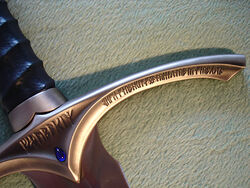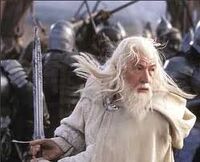Tag: rte-wysiwyg |
Tags: Visual edit apiedit rollback |
||
| (9 intermediate revisions by 8 users not shown) | |||
| Line 9: | Line 9: | ||
It was called '''Beater '''by the Orcs along with "'''Biter'''" {Orcrist}. |
It was called '''Beater '''by the Orcs along with "'''Biter'''" {Orcrist}. |
||
| − | Glamdring was used by Gandalf to slay the [[Great Goblin]] and both Gandalf and Thorin |
+ | Glamdring was used by Gandalf to slay the [[Great Goblin]] and both Gandalf and Thorin Oakenshield used "Glamdring" and "Orcrist" to slay Goblins in the Goblin's caves. |
==Appearance== |
==Appearance== |
||
| Line 39: | Line 39: | ||
|Russian |
|Russian |
||
|Гламдринг |
|Гламдринг |
||
| + | |- |
||
| + | |Lithuanian |
||
| + | |Glamdringas |
||
| + | |- |
||
| + | |Vietnamese |
||
| + | |Chặt Đầu Kẻ Thù |
||
|} |
|} |
||
| − | ==Etymology== |
+ | ==Etymology == |
| − | Glamdring is translated as '''Foe-hammer''' (A [[Sindarin]] word) |
+ | Glamdring is translated as '''Foe-hammer''' (A [[Sindarin]] word). |
==Reproductions== |
==Reproductions== |
||
| Line 65: | Line 71: | ||
[[de:Glamdring]] |
[[de:Glamdring]] |
||
[[es:Glamdring]] |
[[es:Glamdring]] |
||
| + | [[it:Glamdring]] |
||
[[fr:Glamdring]] |
[[fr:Glamdring]] |
||
[[pl:Glamdring]] |
[[pl:Glamdring]] |
||
[[ru:Гламдринг]] |
[[ru:Гламдринг]] |
||
| − | |||
[[Category:Swords]] |
[[Category:Swords]] |
||
Revision as of 20:53, 18 December 2015

Glamdring, Gandalf's sword in Peter Jackson's trilogy Lord of the Rings
Glamdring (also called Foe-Hammer) was a one-and-a-half-handed sword, forged for Turgon, the King of Gondolin during the First Age.
History
Glamdring was used in battle only twice in the First Age; Turgon wielded Glamdring in the Nirnaeth Arnoediad, and in the Fall of Gondolin. For over 6,000 years it went missing, surviving the War of Wrath, until Gandalf (and company) found it (along with Sting and Orcrist) in the trolls' cave in The Hobbit and claimed it for himself. He continued to use Glamdring through the events of The Lord of the Rings, and it is now kept safe in the treasure vault at Minas Tirith.[1]
It was called Beater by the Orcs along with "Biter" {Orcrist}.
Glamdring was used by Gandalf to slay the Great Goblin and both Gandalf and Thorin Oakenshield used "Glamdring" and "Orcrist" to slay Goblins in the Goblin's caves.
Appearance

Rune inscription on Glamdring
Glamdring, along with Orcrist its mate, are described in The Hobbit as having "...beautiful scabbards and jeweled hilts", and Glamdring is referred to by Elrond as "Foe-hammer that the King of Gondolin once wore". In Unfinished Tales, one of the footnotes to the story "Of Tuor and his Coming to Gondolin" mentions that the sword of Turgon was "...white and gold...in a ruel-bone (ivory) sheath,..." While Glamdring is not mentioned by name, it is reasonable to assume that the same sword is described.
Glamdring is inscribed with runes in the Elven language. In the movies released by New Line Cinema and directed by Peter Jackson, the runes say "Turgon Aran Gondolin, Tortha gar a matha Glamdring, Vegil Glamdring gud daelo. Dam an Glamhoth." which translates to "Turgon, King of Gondolin, wields, has, and holds the sword Glamdring, Foe of Morgoth's realm, Hammer of the Orcs." This inscription, however, was not mentioned in any of J. R. R. Tolkien's writings. All Tolkien says in The Hobbit is that the names of the swords were given in the runes, but nothing else is clearly stated. The invented inscription for the movie sword, however, does sound plausible, since Elrond was able to identify that the sword belonged to Turgon.
One problem, though, is that the inscription is given in Sindarin, but in an essay written late in J. R. R. Tolkien's life, he explicitly states that Turgon had re-established Quenya as the language of his household in Gondolin (see The Peoples of Middle-earth, pg. 348). Curiously, it is mentioned in The Hobbit that Gandalf could not read the runes, but that Elrond could, suggesting they were inscribed not in normal Cirth but in some special mode which Gandalf did not know—or, as is more likely, it was at first an inconsistency on Tolkien's part, keeping in mind that The Hobbit had not originally been intended to be so closely woven into the Silmarillion legends. Although the inscription in the film version is Lord of the Rings-era Sindarin and Cirth, the Elvish languages had certainly changed since Turgon's time, so it may be that since Elrond was a survivor from the First Age, he would have been able to read the inscription, whereas Gandalf, who had lived in Aman until the middle Third Age, was not acquainted with it. This seems highly unlikely though, as Quenya originates as an Elvish language from the Undying lands of Aman and is the mode of speech for the Noldorin exiles in Beleriand; which Gandalf would have known in his life as the Maia Olorin.

Gandalf the White with Glamdring during the Battle at the Black Gate.
Often it is forgotten that the Hobbit and the Lord of The Rings are 'historical accounts' written by the Hobbits, Bilbo, Frodo and Samwise. As a Linguist and by default an historian of modes, Tolkien would not have been ignorant of the historical devices put place within ancient texts, both mythic and historical, where the specific details of importance are not altered, in this case, the wording and appearance of Glamdring, but in fact, for poetic effect, the speaker may change. The poetic effect, or adding of depth in this case is that Turgon is Elrond's great grand father, which to accommodate the significance, requires Gandalf to appear buffoonish, or perhaps to be considered to withhold information which would be far too detailed and ruin the poetic depth later on. This may be a 'meta' literary device employed within the technical stance that Bilbo is recording his history of events. Of course this cannot be fully true, as stated above the work with the rest of Arda was not to be so intrinsically included, but it may help to see it in this light.
Like all High-Elven swords, Glamdring was like Orcrist and Sting in that "being the work of Elvish smiths in the Elder Days these swords shone with a cold light, if any Orcs were near at hand,"[2] and so warned their bearers of nearby evil. Glamdring was "bright as blue flame for delight in the killing of the" Great Goblin,[3] but that could have referred to its brightness in that situation; everywhere else in Tolkien's writings, Glamdring's color when glowing is always described as white.
Portrayal in adaptations
Translations around the World
| Foreign Language | Translated name |
|---|---|
| Chinese (Hong Kong) | 敵擊劍 |
| Russian | Гламдринг |
| Lithuanian | Glamdringas |
| Vietnamese | Chặt Đầu Kẻ Thù |
Etymology
Glamdring is translated as Foe-hammer (A Sindarin word).
Reproductions
In addition to the licensed reproduction sword linked below, Del Tin Antiche of Italy made unlicensed interpretations of both Glamdring and Orcrist, which were sold through Museum Replicas, Ltd. back in the mid to late 1980s. These were very high quality steel and well constructed (if quite plain).
Another rather ornate version of Orcrist created by Greg Hildebrandt was issued by Franklin Mint in 1998.
United Cutlery currently manufactures an officially licensed replica of the movie prop. (UC2942)[citation needed]
| Barrow-blades • Sting | |
| Durin's Axe • Orcrist | |
| Grond (battering ram) • Grond (hammer) • Morgul-knife | |
| Aeglos • Anglachel • Anguirel • Angrist • Aranrúth • Belthronding • Dailir • Glamdring • Orcrist • Ringil | |
| Andúril • Dramborleg • Black arrow • Dagmor • Gúthwinë • Gurthang • Herugrim • Narsil • Red Arrow | |
References
- ↑ Lord of the Rings: Weapons and Warfare
- ↑ The Lord of the Rings, The Fellowship of the Ring, Book Two, Chapter IV: "A Journey in the Dark"
- ↑ The Hobbit, Chapter IV: "Over Hill and Under Hill"
